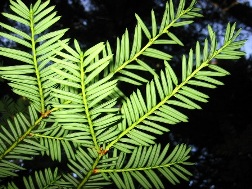Adaptations
 Leaves-
The needle-like leaves of the Pacific Yew are spirally
arranged along the twigs with a darker green on the top
and a paler green on the bottom. This darker top allows
the leaves to absorb as much light coming from above as
possible. It’s also evident that the leaves found on the
trees located in the shade have more area than those on
trees mainly in the sun. This adaptation helps trees
acclimate more to full-sun if the tree canopy was
removed but also helps gain more sun needed for
photosynthesis for those trees located in understory
Leaves-
The needle-like leaves of the Pacific Yew are spirally
arranged along the twigs with a darker green on the top
and a paler green on the bottom. This darker top allows
the leaves to absorb as much light coming from above as
possible. It’s also evident that the leaves found on the
trees located in the shade have more area than those on
trees mainly in the sun. This adaptation helps trees
acclimate more to full-sun if the tree canopy was
removed but also helps gain more sun needed for
photosynthesis for those trees located in understory .
.
Branches- The branches of the Pacific
Yew are extremely long, sometimes as long as the tree is
tall. Because of the increased surface area for leaves
to grow, this is also yet another way for the tree to
gain more sunlight needed for nutritional reasons.
Bark- The bark of this tree is very thin. There’s no
need for the bark to be thick because the Pacific Yew
doesn’t live in a hot environment where water retention
is a absolute necessity.
Fruit structures- Though the fruit-like structures produced by Taxus brevifolia are sweet, they are found to be poisonous to many species who try to eat them like gravers such as cows, sheep or horses. This is an adaptation that discourages prospective predators from eating the fruit and seed so it will be able to grow to maturity and become a new tree.
Make sure to check out the Nutrition page to see how Taxus brevifolia is able to gain the nutrients that it needs.
